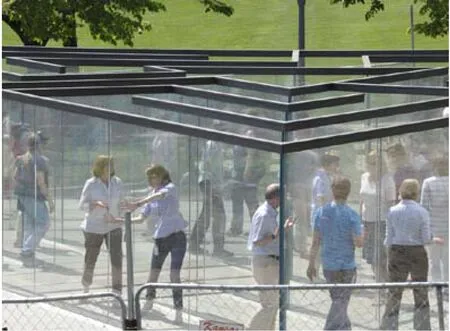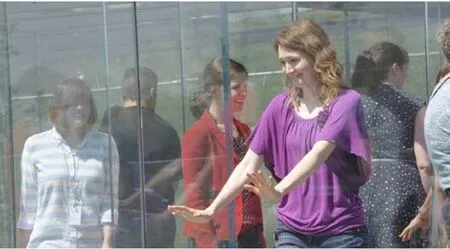玻璃迷宫,密苏里,美国
2016-12-06设计罗伯特莫里斯
设计:罗伯特·莫里斯
玻璃迷宫,密苏里,美国
设计:罗伯特·莫里斯
玻璃迷宫是一个由玻璃墙组成的三角形雕塑。该雕塑的设计者,国际知名的艺术家罗伯特·莫里斯从小在密苏里州的堪萨斯城长大,并将自己的艺术启蒙归功于一次童年时期参观纳尔逊-艾金斯艺术博物馆的经历。
玻璃迷宫高度约2.1m(7ft),三边长约16.8m(55ft),重量超过400t。虽然看起来形式简单,但这座雕塑的建造过程动用了大量人力,并对做工有着非常精细的要求。莫里斯的工程师指导了方案的建造,除此之外还有80名工人参与到建筑实体的搭建过程中。为了纪念唐纳德·J·霍尔雕塑园建立25周年,博物馆委托艺术家设计建造了这座玻璃迷宫。
莫里斯是1960年代以来极简艺术、概念艺术、表演艺术、大地艺术、过程艺术和装置艺术等多个艺术运动之中最重要的人物之一。从风格上讲,玻璃迷宫具有极简主义雕塑和大地艺术一般具备的抽象、简化的形式。虽然在他的职业生涯中,莫里斯利用多种材料创作过多个临时、亦或永久的迷宫式艺术作品,但玻璃迷宫是他在美国本土完成的首个永久性迷宫展品。
玻璃迷宫是雕塑园中的一个标志性存在。当漫步在透明的玻璃墙之间时,参观者们能够获得高度互动化的感官体验。大部分人会在进入迷宫6分钟之后抵达雕塑的中心,之后则原路返回出口。
迷宫起源于希腊神话中关于提修斯和弥诺陶洛斯的传说,之后在中世纪教堂中殿交汇处的地板纹饰中出现,其中最著名的,就属沙特尔大教堂地板上的迷宫纹饰。超现实主义者们曾经进一步挖掘迷宫的意义,使其与弗洛伊德和荣格心理学产生联系,将它类比为对于内在自我的深刻追寻和发掘。这一动机在当代艺术中又得到了进一步延伸,例如安娜·门迭塔的维纳斯之迷宫(1980),以及山本基的迷宫(2012)。千年以来,迷宫一直是人类灵感的不竭源泉。
莫里斯在创作中对于迷宫概念的痴迷延续了40余年。他曾经说过:“迷宫的形式大概是一种探寻自我的转喻,因为它要求人们漫游其中,并放弃对自己所处位置的知觉。”
然而,正如他所读的梅洛-庞蒂以及他的知觉现象学所阐述的,莫里斯认为迷宫并非主要昭示着那些先入为主的神学的、精神层面或者心理学层面的意义,而更多地体现了一种更加当代的、对于感知的理解。梅洛-庞蒂相信我们的身体–尤其是知觉–构成了我们在世间存在的基础。身体,而非头脑,才是知识和存在体验的发生地,并且它与世界亲密交融。感知中的身体,以及它与艺术的关系,成为了莫里斯终身探索主题——玻璃迷宫显然继承了这一点。进入这座具有潜在迷惑性的构筑物中后,参观者/参与者必须强化自己的视觉感知能力,从而辨识出眼前光洁的玻璃墙,并很可能有机会利用触觉和听觉来辅助自己顺利穿过整座迷宫。穿越玻璃迷宫的过程是一次真正意义上的浸入式身体体验。(张裕翔 译)

1 鸟瞰/Aerial view

2 全景/Overall view


3.4 人们在迷宫中行进/Visitors are walking in the maze
评论
贾莲娜:能看透的迷宫恐怕是对现代人生存状态的一种隐喻。看得见,看得多,反而恐怕更难找到方向。作为一个非亲历者,我只能去想象穿行迷宫的过程会有何感受,又强化了我们哪一方面的存在经验。现实的虚妄?视觉的不可靠?看人们纷纷伸出了双手,似乎触觉被激发了。玻璃迷宫让我们看见与他人同在,看到行走在迷宫中的他人,自我的困惑、彷徨显形了,这一点挺有意思。这是一个概念化的、可被体验的装置,它的雕塑感大于它的场所感。它像一个舞台,行走在迷宫中的人们默契地表演着一出剧。
庄子玉:如果说传统迷宫(或者说米诺陶洛斯式的迷宫)折射了人类对于物质世界双重性的迷思(复杂与简单,神秘与可知,感性与理性),那么莫里斯的镜面迷宫则进一步将问题推向了物质世界本体论的边缘(观测者的存在与感知对于客观世界的影响)。故而,前者是心之于物,而后者是物附于心。玻璃迷宫三角形为基本形的构成方式,和以此在多个选择性节点带来歧义空间,不断挑战访者对于“所见即所以”的常规认知,镜面的透射,以及成角度折射及反射在其后的层级中创造了无数空间的可能性和选项。于是在这个边长18m的小空间中,或许某一瞬你就是《盗梦空间》和《西部世界》中的游人,而另一瞬你便成为庄子梦中的蝴蝶。
Comments
JIA Lianna: A perceptive labyrinth is probably a metaphor for the survival state of modern people. With more things to be visible, we might have more difficulties orienting ourselves. Not able to witness it, I can only imagine what people will feel when passing through the labyrinth, and what experience of existence it will strengthen of us. Virtual reality? Or unreliable vision? People stretch out their hands, which seems that their senses of touch are stimulated. The Glass Labyrinth makes us notify others walking along with us in the labyrinth, which also reminds us of our self-confusion. This is interesting. It is a conceptualized device that provides good experience, more like a sculpture than a site. Like an arena, it exhibits the performance that people walking in the maze play in harmony.
ZHUANG Ziyu: If the traditional labyrinth(as the Minotaur labyrinth) reflects the thinking of the dualism of this physical (complicated/ simple, mystery/ comprehensive, sensible/ rational) world, the mirror labyrinth by Robert Morris is put the question a bit forward to the edge of the ontology of the physical world (the observer's body and perception formed the basis for our being). Therefore we consider the former as the object reflecting the heart, and the latter is the object created by heart. The glass labyrinth formed by a series of triangles as the basic shape, which creates many uncertain spaces at the nodes, which keep challenge the visitor's common sense–what you have seen is what it is. The mirror's projection, refraction and reflection in multiple diagonals create numerous space possibilities and options in the subsequent hierarchy. In this case, within this measuring 18×18×18m small space, sometimes you might be the visitors at Inception or Westworld, and sometimes you might be the butterfly in the dream of Chuang Tzu.
Glass Labyrinth is a triangular, glass-walled sculpture designed by acclaimed international artist Robert Morris. He was born and grew up in Kansas City, Missouri and acknowledges childhood visits to The Nelson-Atkins Museum of Art as formative experience for his art.
Glass Labyrinth, seven-foot-tall and measuring 55-foot by 55-foot by 55-foot, weighs more than 400 tons. While the sculpture is deceptively simple, its creation required a large team and much ingenuity to see its realization. Morris's engineer participated and a crew of more than 80 worked on the physical construction. Glass Labyrinth was commissioned by the museum in celebration of the 25th Anniversary of the Donald J. Hall Sculpture Park.
Morris is one of the most important artists associated with the Minimal, Conceptual, Performance, Land, Process and Installation art movements spanning from the 1960s to today.
Glass Labyrinth stylistically relates to the abstract, simplified forms of Minimalist sculpture and Land art. While Morris has created numerous labyrinths of various materials – temporary and permanent – over the course of his career, Glass Labyrinth is the first permanent labyrinth installed in the United States.
Glass Labyrinth is an iconic presence in the Sculpture Park. It provides a highly interactive sensory experience for visitors as they walk between the transparent glass walls. Most who enter take approximately six minutes to reach the center of the sculpture before retracing their steps along the same path to exit.
The labyrinth, with origins in ancient Greek mythology associated with Theseus and the Minotaur, later became the centerpiece in nave crossings of medieval cathedrals, the most notable of which is Chartres. The Surrealists also engaged the labyrinth, making connections between the form and Freudian and Jungian psychology, embracing it as a symbol of the quest to discover the depths of the inner self. The motif continues to be explored in contemporary art as seen in Ana Mendieta's Labyrinth of Venus, ca. 1980 and Motoi Yamamoto's Labyrinth, 2012. The labyrinth has proved to be an endless source of inspiration for millennia.
Morris's fascination with labyrinths in his own work spans four decades. He has stated, "The labyrinth form is perhaps a metonym of the search for the self, for it demands a continuous wandering, a relinquishing of the knowledge of where one is."
Yet, for Morris, the labyrinth represents not as much an interest in mythology, spirituality or psychological preoccupations as a more contemporary understanding of perception, through his reading of Maurice Merleau-Ponty and his Phenomenology of Perception. Merleau-Ponty believed that our body –and especially perception – formed the basis for our being in the world. The body, rather than the mind, was the primary site of knowledge and existence, and the body and the world were intimately intertwined.The sensing body, and its relationship to art, became a life-long preoccupation for Morris and Glass Labyrinth embodies this interest. The visitor/participant, who enters and is enclosed within the potentially disorienting structure, must intensify their visual perception to perceive the extremely clear glass walls, and potentially use touch and hearing to navigate the sculpture. Moving through Glass Labyrinth becomes a truly immersive physical experience.
项目信息/Credits and Data
赞助/Purchase: 由霍尔家族基金会慷慨捐赠/Acquired through the generosity of the Hall Family Foundation
材料/Materials: 玻璃,黄铜和石材/Glass, bronze and stone摄影/Photos: 克里斯·斯玛特,尼尔森-阿金斯艺术博物馆/ Chris Smart, The Nelson-Atkins Museum of Art
Glass Labyrinth, Missouri, USA, 2013
Designer: Robert Morris

5 人们在迷宫中获得感官体验/Visitors get interactive sensory experience in the maze
